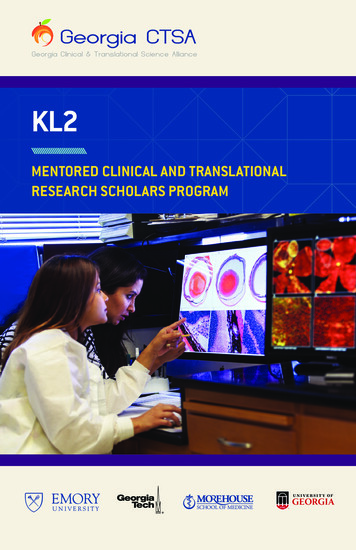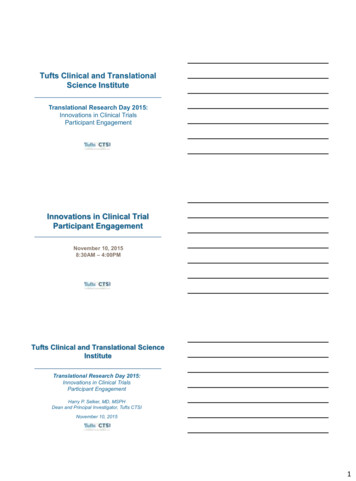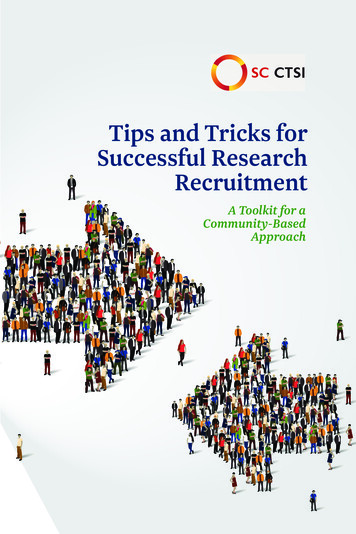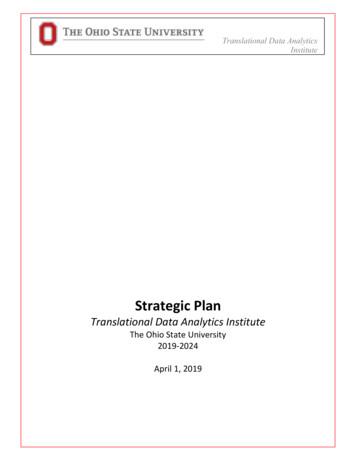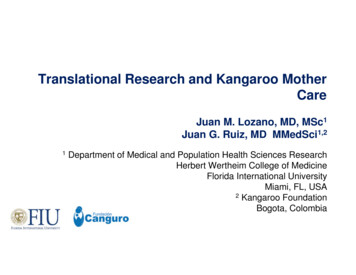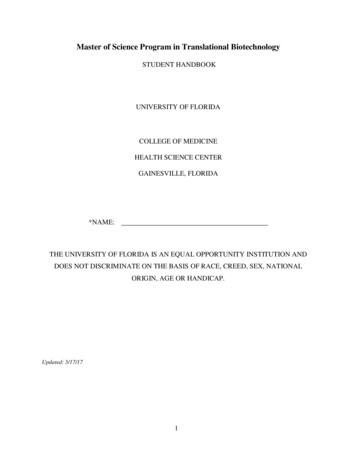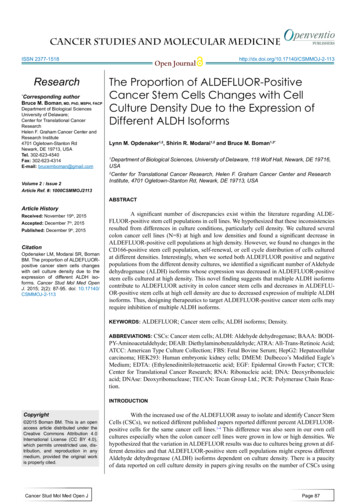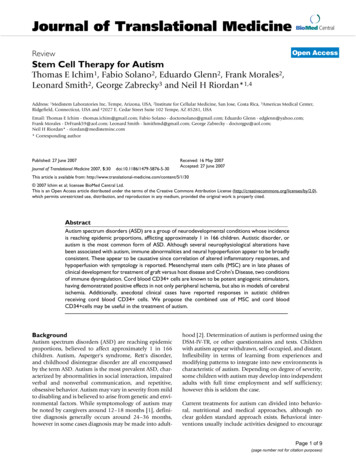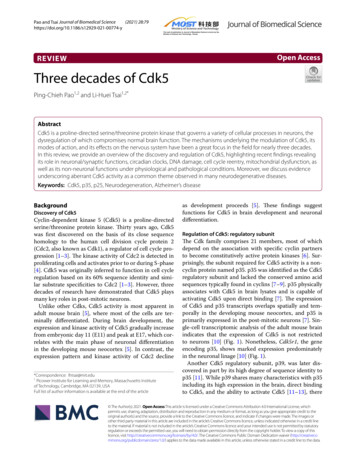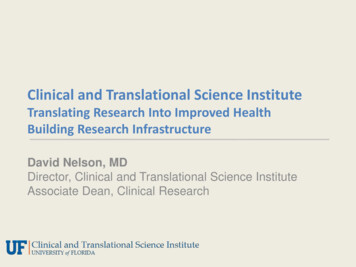
Transcription
Clinical and Translational Science InstituteTranslating Research Into Improved HealthBuilding Research InfrastructureDavid Nelson, MDDirector, Clinical and Translational Science InstituteAssociate Dean, Clinical Research
Outline Challenges– Health of our Nation– The Translation Gap Opportunity– UF Clinical and Translational Science Institute Resources and services Linking patients to consent and samples Clinical trials infrastructure Implementation science: personalized medicine
2000, UC Atlas of Global Inequality http://ucatlas.ucsc.edu/spend.php
Infant Mortality: Common Indicator of the Health of a Country
How Do We Build A Healthier America?Factors That Drive Health OutcomesMortality (length of life)Health OutcomesMorbidity (quality of life)Tobacco useHealth behaviors(30%)Diet & exerciseAlcohol useUnsafe sexClinical care(20%)Health FactorsAccess to careQuality of careEducationEmploymentSocial & economic factors(40%)IncomeFamily & social supportCommunity safetyPrograms andPoliciesPhysical environment(10%)Environmental qualityBuilt environmentAdapted from County Health Rankings model 2010 UWPHI
The Translation Gap for T1 ResearchMore More Output
The Productivity GapNew Molecular Entities and Biologic License ApplicationsAverage R&D cost for each approved drug 1.3 billionNat Rev Drug Disc 2010;9:89-92
Clinical Research to Clinical Practice (T3/T4)-Lost in Translation.NEJM 349(9) 868-874 August 28 2003 both health providers andmembers of the public, arenot applying what we know. we are not reaping the fullpublic health benefits of ourinvestment in research. there is plenty of evidencethat "old" research outcomeshave been lost in translationas well.
It takes 17 years to turn 14 per cent of originalresearch to the benefit of patient careOriginal research18%NegativeresultsvariableSubmission46%0.5 yearAcceptanceNegativeresults0.6 yearPublication35%Lack ofnumbers0.3 yearBibliographic databases50%6. 0 - 13.0 yearsReviews, guidelines, textbookInconsistentindexing9.3 yearsImplementationE.A. Balas, 2000
This is Not a New Problem: The Case of Scurvy 1593 - Sir Richard Hawkinsrecommended the followingtreatment for scurvy: "That whichI have seen most fruitful for thissickness, is sour oranges andlemons." 1601- Lancaster shows thatlemon juice supplementeliminates scurvy among sailors(non-randomized controlled trial) 1747- Lind shows that citrus juicesupplement eliminates scurvy 1795- (194 years after Level 2evidence) British Navyimplements citrus juicesupplement
National Institutes of HealthClinical and Translational Science Awards In 2006, NIH developed the Clinical and Translational Science Award (CTSA) The CTSA consortium vision: to improve human health by transforming research and training environmentto enhance the efficacy and quality of clinical and translational research National Strategic Goals: National Clinical and Translational Research CapacityT1 Translational ResearchThe Training and Career Development of Clinical and Translational ScientistsConsortium-Wide CollaborationsThe Health of our Communities and Nation The 61 CTSA institutions are linked together to transform the local, regional,and national environment to increase the efficiency and speed of clinicaland translational research
CTSA: The National Consortium
UF CTSI Organization
The Translational Research Continuum at UF:An Expansion of T3 and T4 ResearchWhat works undercontrolled icalEfficacyT116%What is the effecton populationhealth“Bedside”(Translation to Humans)18% 14%20%21%T4(Translation toPopulation Health)37%27%48%2008CommunityPractices (Translation toPatients)2011(n 862)Clinical PracticeT2What works inreal worldsettings(n 912)T3How can wechange practice?(Translation to SI Study Registry includes 9,401 human subject research protocols across four IRBs (medical and non-medical)4,497 / 9,401 are considered medical and/or health related protocols3,422 / 4,229 are categorized as translational research (T1 – T4)
Services and Resources for Development of aSuccessful Clinical Research Project Study Design and development– Biostatistics, qualitative/quantitative analysis, ethics, community accessRegulatory and submission help– Online IRB submission (myIRB)– Budget and pricing tool, fixed Medicare rates for research– Research navigators, clinicaltrials.gov support– IND/IDE submission supportDatabase and software development and support– REDCap or customCommunications research consulting (College of Journalism)Recruitment and retention services– StudyConnect, HealthStreet, ResearchMatch– Research Subject Advocate– Integrated Data Repository: Consent2Share and cohort discovery– Community research associatesTissue and sample collection and storage– Biorepository
UF Health Research ConnectionBridging resources for patients, research and care Link patients to researchers– StudyConnect Link researchers to patients– Consent2Share Link patient samples and medical data– Integrated Data Repository Link populations to research community– HealthImpacts– HCV TARGET Translate Discovery into health– Implementation science
Study Registry and StudyConnectStudy Registry: All (9,700) human subject studies approved by 4 UFIRBs from 2008 to date.StudyConnect: Web site with 400 active studies for potential researchparticipants to find opportunities
UF Consent2ShareConsent for Research Use of Tissue and Data Initiated on 9/11/12 Consent form given with admissions packet (pt. specific bar code) Consent asks 2 questions– Can we store your excess tissue with PHI?– Can we re-contact you for a future research study? Collected by admissions clerk, data entered into EPIC, consent formscanned with other documents Patient’s physician can access pt response, answer questions Informed Consent Hotline to answer initial questions– CTSI patient research advocate for more detailed queries Results to date: 4,600 patients completed consent– 79% consent for re-contact for research– 84% consent for storage of tissues/samples
Translational Technologiesand Resources Program Overarching Goal– Develop and Provide basic science tools andservices for research ServicesMichael ClareSalzler, MD––––––––CTSI Biorepository (M. Clare-Salzer)Genotyping (J. Johnson)Biobehavioral (S. Nixon)Human Imaging (S. Lai)Biomedical Mass Spectrometry (T. Garrett)Global Metabolomics (D. Powell)Quality Assurance, GCP, GLP (C. Abernathy)Simulation (S. Lampotang)
CTSI Biorepository Biospecimen collection, processing andstorage. Stored biospecimens can beused by any researcher with IRBapproved protocols.Prospective biospecimen collection tofulfill investigator needs for IRBapproved protocols.Storage for biospecimens collected byinvestigators. Stored biospecimensbelong solely to the investigator.Oversight of the release ofbiospecimens from the UF Departmentof Pathology for other IRB-approvedresearch protocols.Pathology services including thoseprovided by the Molecular PathologyCore and confirmation of diagnosis bya board-certified pathologist uponrequest.One of two Hamilton Storage Technologies’ SAM -80 Cautomated sample management systems (Robotic freezers).The biorepository also has eight Forma Thermo Scientific 80 C Freezers with back-up CO2 and sensaphone alarmsystems including back-up storage space, centrifuge for basicbodily fluid processing, QiaCube for small volume RNA, DNAand protein purification, Agilent Bioanalyzer for RNA, DNA andprotein quality control analysis, OnCore BioSpecimenManagement
Cohort IdentificationIntegrated Data Repository (IDR) Investigators use the IDR(themselves, or stafffacilitated) to identify numbersof patients meeting entrycriteria for trials or data-basedstudies If PHI on the cohort is needed,researchers may requestaccess to the de-identifieddata from the IRB Approved requests result inavailability of a researchspecific data set to theresearcher in a secureenvironmentCurrent content: 297,613 pts, 1.5 million visits from 6/1/11 forward- demographics, diagnoses, procedures, visit details,- PMP, Biorepository, Consent2ShareFor more information: idr.ahc.ufl.edu or ctsi.ufl.edu
Adding the Consent Process and Biorepository to i2b2 for cohort discoveryPrivacy Wall(HIPAA)I2b2 systemResearcherRemove PHIUF & ShandsDataIncludes informedconsent statusInformed consentstatusThe researchercan find out howmany patientshave agreed to becontacted forfuture researchprojects.CTSI BiorepositoryResearch data requestResearchspecific datasetData delivered to researcherHospital \ Clinic EnvironmentIRB request and approvalfor PHI research dataResearch beginsapproved researchResearch Environment
UF Health Research ConnectionBridging resources for patients, research and careUF StudyConnectPARTICIPANTSHEALTH CAREPROVIDERSUF Consent2ShareUF&ShandsIntegrated Data RepositoryRESEARCHERSUF CTSIBiorepository
UF-Affiliated Research Networks Local/ Regional– North Florida Pediatric Community Research Network (Jacksonville area)– Jacksonville Health Equity Research Organization Practice-Based ResearchNetwork (JaxHERO)Statewide– Health IMPACTS for Florida (UF-FSU statewide research network)– Florida Neonatal Neurologic NetworkNational– NHLBI Cardiovascular Cell Therapy Research Network (Carl Pepine)– NIDCR Dental Practice-Based Research Network (Valeria Gordan)– Hepatitis C Therapeutic Registry and Research Network (HCV-TARGET, Nelson)– Network for Pancreatic Organ Donors with Diabetes (nPOD)– NIH Pharmacogenomics Research Network (Julie Johnson)– Sentinel Network for Community-Based Participatory Research (Linda Cottler)
UF-FSU Community Research ProgramGoal: Test interventions in physicianpractices;Translate research findings intoimproved health care quality; andMentor medical students andtrainees in conducting researchand implementing researchfindings in practice.Two pilot projects: Sports related concussion surveillanceand management (PI: Bauer) Health risk assessment amongadolescents in primary care (PI:Shenkman)Funding: UF/FSU( 500,000) State of Florida ( 600,000) NIH ( 473,000)
Clinical and Translational Research BuildingsCTRB- CTSI, IOA, Biostats, Epi,Health Outcomes & Policy- 120,000 ft2 total- 20,000 ft2 patient research- Open: March 2013Lake Nona-Orlando- CTSI IOA- Clinical research unit- Community engagement- HealthIMPACTS- HealthStreet-Center for Pharmacometricsand Systems Pharmacology-SBRI and OH partnership
Hepatitis C Therapeutic Registryand Research NetworkClinicalTrials.gov Identifier: NCT01474811 Mission: to establish a nationwide registry of patients undergoing treatment withnew therapies for HCV at both academic and community practices Specific aims– Improve information of populations underrepresented in phase III trials– Identify and remediate educational gaps and adverse event management– Serve as a core for collaborative, translational studies Structure– Chairs: Nelson (UF) : clinical coordinating center and biorepository Fried (UNC): data coordinating center (REDCap-based)– Trial network: 27 academic institutions and associated communityengagement outreach; centralized data collection service Highlights– Partnership: academia industry FDA/EMA– Funding: 12 million– 1,500 pts enrolled to date (approx 200/month)
HCV-TARGETOverview Longitudinal, observational study– Prospective and sequential, retrospective cohorts enrolling Inclusion criteria:– Adult patients ( 18 years) being treated with or who have beentreated with antiviral regimens that contain oral direct actingantiviral agents Exclusion criteria:– Inability to provide written informed consent unless waiver ofinformed consent granted by local IRB Biorepository: baseline DNA and serum at key timepoints– Baseline, EOT (protocol or breakthrough/relapse), follow-up SVR(12 or 24)
Primary Specific Aims Safety and efficacy in populations represented and underrepresentedin phase III clinical trials- African Americans / Hispanics, cirrhosis, null responders, age 65- Subgroup analyses to determine the cumulative influence of IL28B,fibrosis, viral subtype (1a vs 1b), other co-morbidities To refine point estimates and narrow confidence intervals Adverse event surveillance and management- Anemia, rash, anorectal, dysgeusia, etc Virologic breakthrough and resistance Biorepository sample collection Impact of viral load measurement on treatment efficacy Compliance / utility of current futility rules Clinical relevance of “detectable / BLOQ” vs “undetectable” Evaluate/inform FDA pharmacometric modeling Unstudied populations and dosing regimens
HCV TARGET Organizational ChartDavid Nelson-UFMichael Fried-UNCSteering CommitteeClinical CoordinatingCenterBioRepositoryData CoordinatingCenterDi Bisceglie, Jacobson,Jensen, Sulkowski, Terrault,EU RepPublicationCommitteeChair: ReddyPharma AdvisoryCouncilProject Management-EMA/FDAAdvisoryCouncilJoy PeterCommunityAdvocateLynda DeeDCCConsultantsStatisticsData ManagementMonika VainoriusContractingREDCap Data ManagerRegulatory DirectionLauren MorelliU.S.Investigators(Academic &Community)Centralized Chart DataAbstractorsU.S. CoreGermanyCoreUK CoreEUInvestigators(Academic &Community)CRA’sFranceCore
Building an International ConsortiumAKCanadaNVHIPRParticipating InstitutionsAcademic SiteCommunity Site
Implementation ScienceUF&Shands Personalized Medicine Program Background– Human genome project completed in 2001– Collins (NIH): expectation that an individual’s personal genome will bepart of their medical record, from which information can be pulled todetermine disease risk or guide treatment decisions Challenge– Despite the substantial number of important genetic discoveriesmade, there are limited examples of clinical translation to practice UF Objectives for Personalized Medicine Program– Engage UF&Shands Health System as leaders in genetic-guided care– Pre-emptively genotype on broad panel (256 SNPs) to mimic eventualreality of genomic data in EMR Prepare health informatics systems to handle increasing amountsof genetic data linked into EMR Define when and how to use genetic data in patient care
Personalized Medicine ProgramLaunched June 25, promise-personalized-medicine-heartpatients#!/-1/
Clinical Translation in Genomics and PharmacogenomicsUF&Shands Personalized Medicine InitiativeClopidogrel (Plavix): genetic polymorphism of CYP2C19 leads to reducedability to activate clopidigrel and increased risk of cardiovascular complicationCER, Economic Impact“Front door” consent;Bioethics; CommunicationsResearchBiorepositoryBMI; Hospital IT; EpicGenotyping CoreIDR; Bioinformatics; Research IT
NHGRI Genomic MedicineImplementation Science
UF CTSI’s VisionImproving the health of Florida’s communities with a focuson prevention and an emphasis on team science Learning Health System– “one which progress in science, informatics, and care culture align to generatenew knowledge as an ongoing, natural by-product of the care experience, andseamlessly refine and deliver best practices for continuous improvement inhealth and health care” (IOM, 2007)– Put CTS research to work on health system priorities: quality, effectiveness,safety Linkage as “One Florida”– Cultivating an ability to work together with public and private partners todevelop statewide collaborations and networks UM CTSA award and statewide initiatives Human Investment-Team Science– Develop and sustain current and future translational researchers andstrengthen the research workforce– Team science approach as basis for both patient care and research
UF-FSU Community Research Program Goal: Test interventions in physician practices; Translate research findings into improved health care quality; and Mentor medical students and trainees in conducting research and implementing research findings in practice. Two pilot projects: Sports related concussion surveillance
